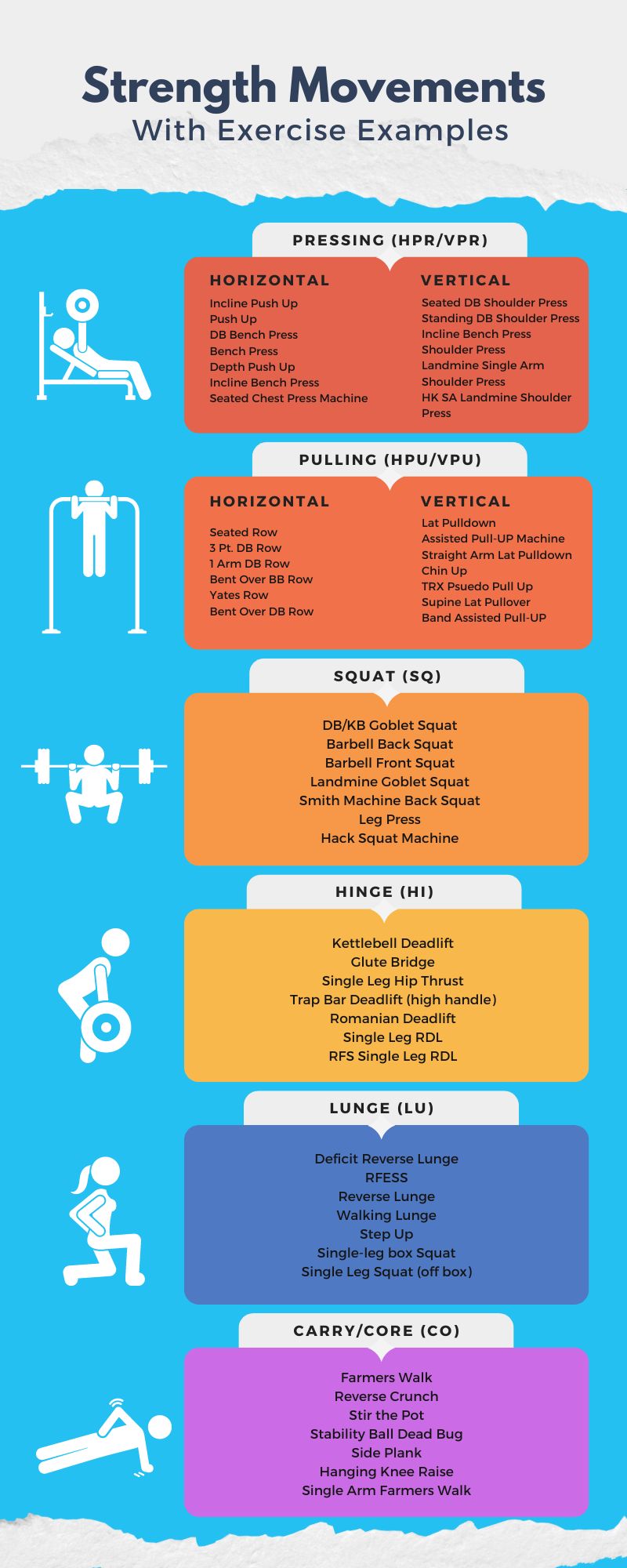The 6 Essential Strength Movements for Health and Longevity
When it comes to strength training, simplicity often beats complexity. The foundation of any effective workout routine consists of six essential movements: Pressing, Pulling, Squatting, Hinging, Lunging, and Core work. These fundamental exercises are not just for athletes or bodybuilders—they’re crucial for everyone looking to maintain strength, mobility, and overall health as they age. Let’s dive into why these six movements are so important for your health and longevity.
Pressing: Enhancing Upper Body Strength
Pressing movements, like the overhead press and bench press, are key exercises for building upper body strength. These exercises target the muscles of the chest, shoulders, and triceps, which are involved in many everyday activities—from lifting objects overhead to pushing open a heavy door.
Incorporating pressing exercises into your routine helps build strength that’s practical and functional. Whether you’re carrying groceries, playing a sport, or lifting your kids or grandkids, pressing movements develop the upper body power needed for these tasks.
Pulling: Building a Strong, Balanced Upper Body
Pulling exercises, such as rows and pull-ups, are essential for developing the muscles of the back and arms. These movements complement pressing exercises by targeting the opposing muscle groups, creating a balanced upper body workout.
A strong back is crucial for many activities that involve pulling or lifting. Whether you’re pulling yourself up, carrying bags, or doing any number of daily tasks, pulling exercises help build the strength needed to handle these challenges effectively.
Squatting: The Ultimate Lower Body Builder
Squats are often considered the foundation of any lower body workout. This movement engages several muscle groups at once, including the quads, hamstrings (to a lesser extent), glutes, and calves, making it one of the most efficient exercises for building leg strength.
Beyond the gym, the benefits of squatting are evident in daily life. From getting up from a chair to picking something up from the floor, squatting is a natural movement that we perform regularly. By incorporating squats into your workout, you’re not just building stronger legs—you’re training your body to perform everyday movements with greater ease and strength.
Hinging: Strengthening the Posterior Chain
Hinging movements, like deadlifts, focus on the muscles of the posterior chain—glutes, hamstrings, and lower back. These muscles are key for many dynamic movements and provide a solid foundation for both strength and power.
The hinge pattern is particularly effective for activities that require bending and lifting. Whether you’re lifting a suitcase, picking up a heavy box, or engaging in sports, hinging exercises develop the strength and coordination needed for these tasks.
Lunging: Improving Single-Leg Strength and Balance
Lunges are an excellent exercise for building strength in the legs and improving balance and coordination. Unlike squats, which use both legs simultaneously, lunges require you to work each leg independently, helping to develop balanced strength on both sides of the body.
Lunging also mirrors many natural movements, such as stepping forward, climbing stairs, or walking up a hill. By including lunges in your routine, you’re training your body to move more effectively and confidently in a variety of situations.
Core Work: Building Stability and Strength
Core exercises are crucial for developing the muscles that stabilize the spine and support the body during movement. A strong core enhances performance in all other strength movements and contributes to overall functional fitness.
Core work involves more than just crunches; it includes a variety of exercises like planks, rotational movements, and anti-movement exercises that train the muscles to work together effectively. A strong core provides the stability needed for lifting, bending, and twisting movements in both exercise and daily life.
The Bottom Line: Focusing on the Fundamentals for a Stronger, Healthier You
By incorporating these six essential movements into your strength training routine, you’re building a balanced and resilient body that’s equipped to handle the physical demands of everyday life. Whether your goal is to stay active, build strength, or maintain your independence as you age, these fundamental exercises lay the groundwork for lifelong health and vitality.
Stick to the basics, focus on quality movement, and enjoy the benefits of a stronger, healthier you. Remember, the best way to enhance your fitness is to keep things simple, effective, and consistent. Happy lifting!

